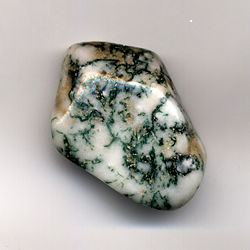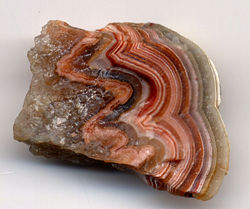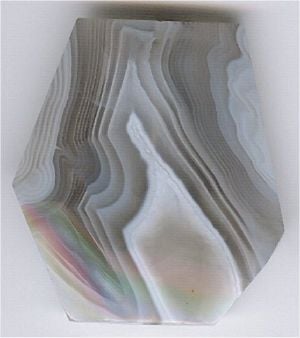Agate
{{#invoke:Message box|ambox}}
- For other uses, see Agate (disambiguation).
| Agate | |
|---|---|
 Moss agate pebble, 2.5 cm (1 inch) long |
|
| General | |
| Category | Mineral |
| Chemical formula | Silica, SiO2 |
| Identification | |
| Color | White to grey, light blue, orange to red, black. |
| Crystal habit | Cryptocrystalline silica |
| Crystal system | Rhombohedral Microcrystalline |
| Cleavage | None |
| Fracture | Conchoidal with very sharp edges. |
| Mohs Scale hardness | 7 |
| Luster | Waxy |
| Refractive index | 1.530-1.540 |
| Birefringence | up to +0.004 (B-G) |
| Pleochroism | Absent |
| Streak | White |
| Specific gravity | 2.58-2.64 |
Agate is a type of quartz (silica), chiefly chalcedony, characterised by its fineness of grain and brightness of color. Although agates may be found in various kinds of rock, they are especially common in metamorphic rock.[1]
The colorful agate and other chalcedonies were obtained over 3,000 years ago from the Achates River, now the Drillo, in Sicily.[2]
Formation and characteristics
Most agates occur as nodules in volcanic rocks or ancient lavas where they represent cavities originally produced by the disengagement of volatiles in the molten mass which were then filled, wholly or partially, by siliceous matter deposited in regular layers upon the walls. Such agates, when cut transversely, exhibit a succession of parallel lines, often of extreme tenuity, giving a banded appearance to the section. Such stones are known as banded agate, riband agate and striped agate.
In the formation of an ordinary agate, it is probable that waters containing silica in solution — derived, perhaps, from the decomposition of some of the silicates in the lava itself — percolated through the rock and deposited a siliceous coating on the interior of the vapour-vesicles. Variations in the character of the solution or in the conditions of deposit may cause corresponding variation in the successive layers, so that bands of chalcedony often alternate with layers of crystalline quartz. Several vapour-vesicles may unite while the rock is viscous, and thus form a large cavity which may become the home of an agate of exceptional size; thus a Brazilian geode lined with amethyst and weighing 67 tons was exhibited at the Dusseldorf Exhibition of 1902.
The first deposit on the wall of a cavity, forming the "skin" of the agate, is generally a dark greenish mineral substance, like celadonite, delessite or "green earth", which are rich in iron probably derived from the decomposition of the augite in the enclosing volcanic rock. This green silicate may give rise by alteration to a brown iron oxide (limonite), producing a rusty appearance on the outside of the agate-nodule. The outer surface of an agate, freed from its matrix, is often pitted and rough, apparently in consequence of the removal of the original coating. The first layer spread over the wall of the cavity has been called the "priming", and upon this base zeolitic minerals may be deposited.

Many agates are hollow, since deposition has not proceeded far enough to fill the cavity, and in such cases the last deposit commonly consists of quartz, often amethyst, having the apices of the crystals directed towards the free space so as to form a crystal-lined cavity, or geode.
On the disintegration of the matrix in which the agates are embedded, they are set free. The agates are extremely resistant to weathering and remain as nodules in the soil or are deposited as gravel in streams and shorelines.
Types of agate
A Mexican agate, showing only a single eye, has received the name of "cyclops agate." Included matter of a green, golden, red, black or other color or combinations embedded in the chalcedony and disposed in filaments and other forms suggestive of vegetable growth, gives rise to dendritic or moss agate (named varieties include Maury Mountain, Richardson Ranch, Sheep Creek and others). Dendritic agates have beautiful fern like patterns on them formed due to the presence of manganese and iron ions. Other types of included matter deposited during agate-building include sagenitic growths (radial mineral crystals) and chunks of entrapped detritus (such as sand, ash, or mud). Occasionally agate fills a void left by decomposed vegetative material such as a tree limb or root and is called limb cast agate due to its appearance.
Turritella agate is formed from fossil Turritella shells silicified in a chalcedony base. Turritella are spiral marine gastropods having elongated, spiral shells composed of many whorls. Similarly, coral, petrified wood and other organic remains or porous rocks can also become agatized. Agatized coral is often referred to as Petoskey agate or stone.
Greek agate is a name given to pale white to tan colored agate found in Sicily back to 400 B.C.E. The Greeks used it fo making jewelry and beads. Today any agate of this colour from Greek/Sicily area of the Mediterranean is called Greek agate.
Another type of agate is Brazilian agate, which is found as sizeable geodes of layered nodules. These occur in brownish tones interlayered with white and gray. Quartz forms within these nodules, creating a striking specimen when cut opposite the layered growth axis. It is often dyed in various colors for ornamental purposes.
Certain stones, when examined in thin sections by transmitted light, show a diffraction spectrum due to the extreme delicacy of the successive bands, whence they are termed rainbow agates. Often agate coexists with layers or masses of opal, jasper or crystalline quartz due to ambient variations during the formation process.
Other forms of agate include carnelian agate (usually exhibiting reddish hues), Botswana agate, Ellensburg blue agate, blue lace agate, plume agate (such as Carey, Graveyard Point, Sage, St. Johns, Teeter Ranch and others), tube agate (with visible flow channels), fortification agate (which exhibit little or no layered structure), fire agate (which seems to glow internally like an opal) and Mexican crazy-lace agate (which exhibits an often brightly colored, complex banded pattern).
Agate beliefs
In many traditions agate is believed to cure the stings of scorpions and the bites of snakes, soothe the mind, prevent contagion, still thunder and lightning, promote eloquence, secure the favour of the powerful, and bring victory over enemies.[citation needed] Persian magi are also known to have prized agate rings in their work and beliefs.
Pagan religions also believe agate is a crystal whose powers can be used for love, mental clarity, and good luck in card games.
Shia Muslims often wear an agate ring on the right hand, the stone engraved with the name of Allah, Ali, or the names of the other eleven Imams. It is known as "aqaq" or "agag" in Persian.
Uses in industry
Industry uses agates chiefly to make ornaments such as pins, brooches, paper knives, inkstands, and seals. Because of its hardness and ability to resist acids, agate is used to make mortars and pestles to crush and mix chemicals.
See also
- List of minerals
- Lake Superior agate
- Fire Agate
Notes
- ↑ Donald W. Hyndman, David D. Alt (2002). Roadside Geology of Orgeton, 18th, Missoula, Montanat: Mountain Press Publishing Company, p. 286. ISBN 0-87842-063-0.
- ↑ Agate Creek Agate. Retrieved 2207-07-01.
ReferencesISBN links support NWE through referral fees
- The Nomenclature of Silica by Gilbert Hart, American Mineralogist, Volume 12, pages 383-395, 1927
- International Colored Gemstone Association
- Mindat data
- Schumann, Walter. Gemstones of the World. 3rd edition. New York: Sterling, 2006.
- http://www.gemstone.org/gem-by-gem/english/agate.html
| Gemstones and crystals | |
|---|---|
| Gems: | Aquamarine · Emerald · Jasper · Lapis lazuli · Pearl · Peridot · Ruby · Sunstone · Tiger's eye |
| Crystals: | Agate · Amethyst · Chalcedony · Diamond · Pyrite · Quartz · Rhodochrosite · Sapphire · Topaz · Tourmaline |
ar:عقيق bg:Ахат da:Agat de:Achat et:Ahhaat es:Ágata (mineral) eo:Agato fa:عقیق fr:Agate is:Agat it:Agata (minerale) he:שבו lv:Ahāts lt:Agatas hu:Achát nl:Agaat ja:メノウ ug:ھېقىق pl:Agat pt:Ágata ro:Agat ru:Агат sk:Achát sl:Ahat sr:Ахат fi:Akaatti sv:Agat th:โมรา tr:Akik uk:Агат (мінерал) zh:瑪瑙

